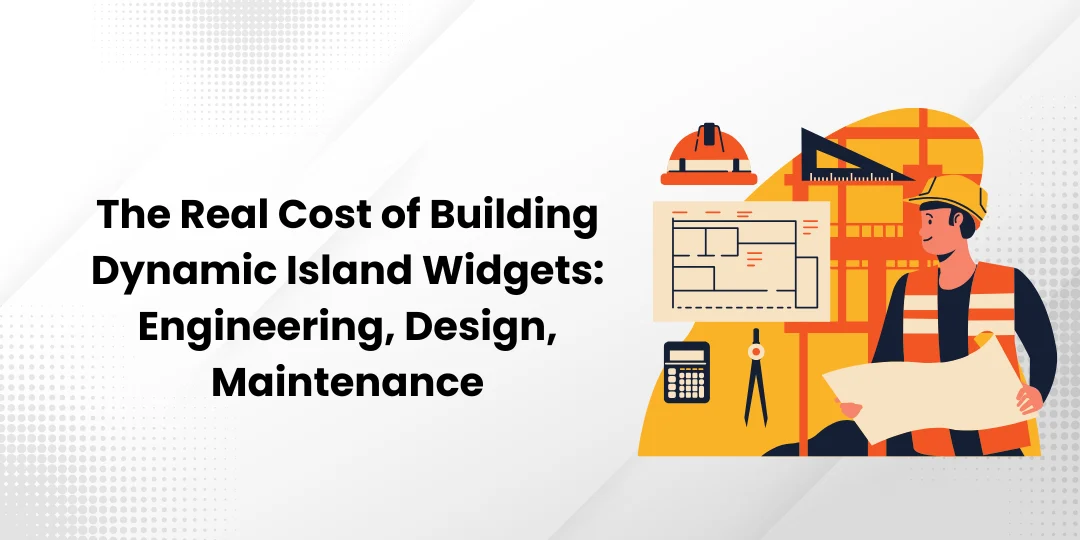
Companies often underestimate the real effort that goes into building high-quality Dynamic Island extensions. Even the tiniest surface can demand deep work behind it. Therefore, developers thoroughly review the architecture, shape a clear and intuitive microinterface, and ensure everything remains reliable. The challenge increases as user needs evolve and product requirements expand over time.
With each new Dynamic Island experience, engineers revisit their workflows, refine rendering logic, update pipelines, and fine-tune motion behaviors to keep everything feeling seamless.
Designers consider factors such as glanceability, speed, context, and visual focus. Engineers should strike a balance between code efficiency, animation timing, and system limitations to achieve optimal performance.
Long-term work presupposes more responsibility, especially when Apple releases new OS versions or updates how users interact with the feature. Together, all these elements transform the project into a layered commitment, one that companies must weigh carefully before undertaking any development.
Engineering Workloads Required for Dynamic Island Functionality
Engineering complexity is typically the first major cost category that teams encounter when building these components. Although the entry point may seem straightforward, the technical realities require a deeper understanding.
Developers handle event processing, lifecycle management, content formatting, and performance constraints simultaneously. For example, a few glitches can make the users’ experience less comfortable when seeking just quick updates or a short status check.
Here are several engineering tasks that need to be coordinated in this case:
- Showing quick updates.
- Ensuring that information is always up-to-date and accurate.
- Checking transitions so animations stay smooth.
- Tracking crashes, flickers, or any unexpected slowdowns.
Additionally, engineers need to test and implement every part of a Dynamic Island widget in real-time, as even minor delays can undermine user confidence when using the feature.
Integrations with notifications, live activities, or background processes add additional layers of technical work. These interconnected systems demand focused testing across multiple devices and OS versions to guarantee consistency. Detailed QA passes, stress tests, and fallback logic become mandatory parts of the engineering budget.
As new functionality arrives from Apple each year, developers must rewrite portions of the codebase, optimize performance, or extend features to match updated system rules. This ongoing cycle becomes a long-term engineering obligation that product teams just cannot ignore.
Investing in Design for Dynamic Island Interfaces
Designing a Dynamic Island widget can be costly, often much more than initially expected or estimated. Designers have a complex task ahead of them: to create highly condensed information patterns without overwhelming the viewer within a tiny area.
Crafting something meaningful inside this small, animated container, creators must determine how to structure:
- quick previews;
- real-time feedback;
- motion timing;
- color balance;
- Information priority.
Even on a small screen, customers want the motion design to feel smooth and intuitive, and the visuals should not affect clarity or seem stressful.
Thus, within the next phase of Dynamic Island development, designers will refine how idle, expanded, active, and error states behave, enabling users to easily follow the context, notice changes, and transition smoothly through each state.
However, each new cycle of testing often extends the design timeline further than expected.
Teams also need to uphold brand clarity without overshadowing the small interface, which requires steady iteration and close coordination across disciplines.
Engineers face a personal challenge in maintaining a brand identity within such a limited space. Reaching that balance involves refining ideas, testing multiple prototypes, and working closely with product, design, and engineering partners.
Maintenance Costs That Often Get Overlooked
It may seem like the most expensive thing to do is continually creating Dynamic Island widgets, but in truth, long-term maintenance typically requires considerable time and effort.
For instance, Apple regularly updates its frameworks, adjusts animation behaviors, introduces new constraints, and adds new features. Each of these changes involves reviewing their earlier decisions and updating their implementation appropriately.
As a result, businesses may face the following issues:
- Updating components after new OS releases.
- Re-testing animation across new devices.
- Adjusting designs to match updated guidelines or technical limits.
- Tracking performance.
- Fixing issues when system changes.
In this changing world of user expectations and patterns, even a small enhancement can often become the element that keeps the experience feeling fresh. Products grow through steady, intentional adjustments that reflect how people actually use them.
It is essential that product owners monitor engagement levels, interaction frequency, error trends, and completion patterns to determine whether a widget remains effective and continues to deliver meaningful value to customers. Based on this data, developers often build new capabilities, such as smarter triggers, refined interface details, or completely new features.
Ultimately, maintaining a sustainable product depends on studying user needs and guiding decisions with a thoughtful, long-term strategy.
If companies want to avoid unwanted costs that may emerge later, they should always be prepared for the fact that the Dynamic Island has also become an integral part of this ongoing process.
Combining New Opportunities and Thoughtful Decision-Making
Actually, not every product needs micro-surface interactions, as some systems work perfectly well without rapid updates or background signals.
When the feature genuinely supports a real-time scenario, such as delivery updates, timers, or active tracking, users appreciate the added convenience. And in those cases, the investment feels truly justified.
At the same time, plenty of concepts slow down once they reach the feasibility review stage. If the content isn’t urgent, relevant, or visually clear, the component may ultimately add little value to the audience.
A solid ROI review depends on how effectively teams remain realistic about outcomes, and consider the following processes aligned:
- Engineering effort vs. real utility.
- Design time vs. user clarity.
- Maintenance cost vs. long-term engagement.
No doubt, making informed decisions helps avoid unnecessary work and ensures that each release drives the product growth.
Final Thoughts
Building high-quality widgets for the Dynamic Island demands serious technical, creative, and operational investment. Engineering challenges, design intricacies, and ongoing maintenance combine into a long-term commitment. Teams that recognize these responsibilities from the start can allocate resources wisely and produce interactions that feel meaningful, smooth, and reliable. Careful planning consistently yields better results and stronger user satisfaction.





